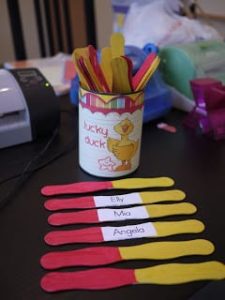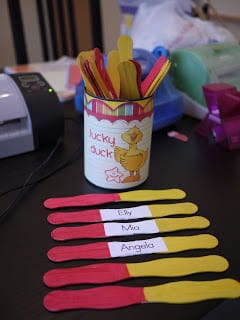Student Contributor: B. Wells
 Popsicle Sticks are in a cup and each one has the student’s name on it in the class, which help to easily form groups. This supports students because forming groups is one less thing a student has to worry about. All students end up with a partner or will end up in groups smoothly and easily.
Popsicle Sticks are in a cup and each one has the student’s name on it in the class, which help to easily form groups. This supports students because forming groups is one less thing a student has to worry about. All students end up with a partner or will end up in groups smoothly and easily.
Each popsicle stick has the students name on it and they are found in a cup. When it is desired that the students work in groups, the teacher will draw a few popsicle sticks from the cup (however many the teacher desires to be in each group). Those students on the sticks will now be a group. Something to keep in mind is to plan ahead for students who are absent and can therefore affect the grouping and needs be carefully thought through. I have had experience with this tool in Gus’s class, where he used popsicle sticks to group us
The phase that the popsicle stick tool falls under is the supportive phase. This tool would be with this phase because it is a way to help students to get into a group without getting left out or being the last one who doesn’t have a partner. When you tell your class, they can pick their own groups. Popsicle sticks supports a child in this, it avoids the panicky feeling of not finding a group. The theory that this falls under is the student-directed and collaboration theory. The popsicle sticks are made and used by the teacher. However, they are for the students and is focused on the students to make grouping easier for both, the teacher and the student. Students can also pull popsicle sticks from the cup (quickly grabbing a couple, and not picking the ones they want) to form groups, which gives the students more control.
More Information –
Tool Source: Professor Nollmeyer


